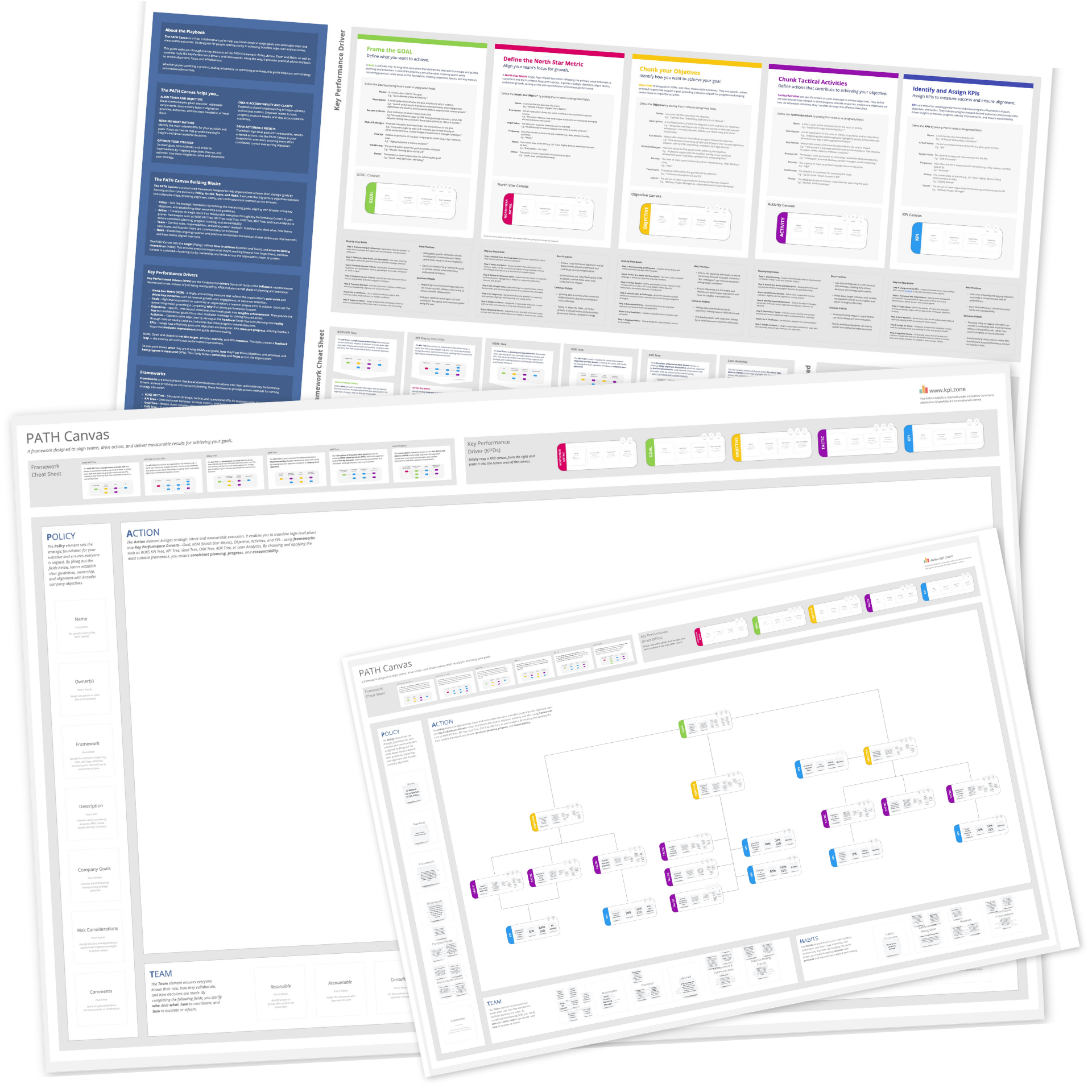Table of Contents
Classic. You set a target: 500 MQLs. Teams scramble. Campaigns launch. Content floods the funnel. Numbers climb. 🎉
And then the deals don’t close.
Why? Because you confused the metric with the mission.
You weren’t optimising for revenue. You were optimising for a label.
That’s surrogation.
Wait! What’s Surrogation?
Surrogation is what happens when a measure of success becomes mistaken for the success itself.
It starts innocently. You set a KPI to represent a strategic goal – say, daily active users as a proxy for product engagement. But over time, the metric becomes the goal. You stop asking why you’re measuring it and start managing to it.
The result? You might grow the number and miss the mission.
It’s not stupidity. It’s psychology.
Why Smart Teams Fall for Surrogation
No one sets out to confuse a metric with the mission. But it happens all the time.
Here's why.
Psychological Drivers
At the core? Our brains hate ambiguity.
Big strategic goals, like “delight the customer” or “drive long-term impact, are fuzzy. They’re hard to evaluate. So we unconsciously reach for something clearer: a number.
This is called attribute substitution — a mental shortcut identified by Daniel Kahneman. When faced with a tough question, our brain swaps in an easier one.
So instead of asking, “Are we delivering long-term value?”
We start asking, “Is the chart going up?”
Here’s how that plays out:
- Cognitive ease: Numbers feel certain. Strategy feels squishy.
- Simplicity bias: One clean KPI feels better than a messy truth.
- Overconfidence: We assume metrics are reality, not just a slice of it.
Organizational Drivers
Now layer on company culture—and things accelerate.
- Incentives: Tie pay or promotions to a single metric, and it will become the mission.
- Dashboard culture: Constant visibility turns numbers into goals —whether they should be or not.
- Communication shortcuts: Metrics become the language of progress. Strategy gets lost in translation.
- Cultural repetition: If every meeting starts with KPIs, people assume that’s all that matters.
Over time, people stop asking what the number means. They just focus on moving it.
The risk? You hit the target... and miss the point.
So What Does That Look Like in Real Life?
It doesn’t start with someone shouting, “Let’s ignore the strategy!”
It starts small.
A metric shows up on a dashboard.
Then in a meeting.
Then in your bonus plan.
And before you know it, the team’s chasing the number, not the goal.
Here’s how to tell if surrogation has already crept into your team.
- Everyone talks about the number, not the goal.
- Metrics are gamed or padded without real value.
- Dashboards dominate; strategic intent disappears.
- Decisions get made for optics, not for impact.
- You’re “winning the spreadsheet”, but losing trust, morale, or margin.
If any of that hit a little too close to home—good. Awareness is where real change starts.
A Metric Is a Map, Not the Terrain
If those warning signs feel familiar, don’t panic.
Avoiding surrogation doesn’t mean ditching metrics. It means using them as tools, not truths.
The best teams stay agile by:
- Measuring what matters, not just what’s easy to count
- Staying close to real customers, not just reports
- Adjusting KPIs as the market, strategy, or signals shift
That’s why “Measuring what matters” isn’t just a slogan—it’s survival.
When a metric becomes the mission, people will game the system, pad the numbers, or shift priorities. Not to cheat, but to win by the rules you set. Even when it costs the strategy.
They weren’t trying to fail.
The metric just got louder than the mission.
It’s a sharp reminder: Metrics are double-edged swords. They’re powerful when they clarify intent. But lose the “why,” and they’ll quietly steer you off course.
Strategy-to-Execution: How to Prevent Surrogation
We’ll tackle this on three levels: Strategic, Tactical, and Operational. Each layer matters. Together, they build a culture that tracks what counts—without getting lost in the numbers.
Strategic Level: Keep the “Why” in Sight
Metrics without meaning are just noise. At the strategic level, your job is to make sure every number connects to a clear purpose. Here’s how:
1. Define Clear Strategic Intent
Every KPI should answer a strategic question:
“What does this help us learn?”
Not just “What does this track?”
If your team can’t explain the why behind a metric in plain language, you’re already on shaky ground.
2. Use Strategy Maps or Logic Models
Make the logic visible. Visual tools like the PATH Canvas help connect the dots between actions, outcomes, and long-term goals. Don’t expect people to guess how a number ties to the mission; show them.

3. Combine Numbers with Stories
Metrics spark questions. Stories make meaning.
A good dashboard starts the conversation. A great one brings in qualitative signals like customer feedback, support transcripts, field notes, and product anecdotes.
📚 Brent Dykes nails this in “Effective Data Storytelling”: data alone doesn’t drive action. Narrative bridges the gap between insight and impact.
If you’re serious about turning numbers into influence, put this book on your bucket list. It’s a tactical guide to communicating metrics that actually move people.
4. Lead with Strategy, Not Scorecards
Metrics follow strategy—not the other way around. Leaders should regularly ask:
“How does this move the mission?”
Not just “Did we hit the number?”
When executives model strategic thinking over scoreboard obsession, the culture follows.
Tactical Level: Build a Balanced Metric System
Once the strategy is clear, you need metrics that reflect reality—not distort it. A balanced metric system guards against tunnel vision and drives smarter decisions across the org.
1. Use Metric Clusters
Never fly on one dial. Pair quantity with quality, input with output, and leading with lagging indicators. This keeps your view grounded and your actions well-rounded.
2. Add Guardrail Metrics
For every goal, ask, “What could go wrong if we push this too hard?” Then track that risk too.
- Growing fast? Watch churn.
- Cutting costs? Monitor NPS.
- Shortening response time? Check resolution quality.
Metrics work best in pairs that challenge each other.
3. Review Metrics Cross-Functionally
Let marketing challenge ops. Let product poke holes in sales numbers.
Why? Different teams spot different blind spots.
Cross-functional reviews reduce echo chambers and help catch early signs of metric misuse.
4. Change Metrics as Strategy Evolves
Your KPIs should grow with your business.
Don’t lock into metrics just because they’ve always been there. Revisit them quarterly. Ask:
“Is this still measuring what matters?”
If not, cut it or upgrade it. Strategy isn’t static. Your metrics shouldn’t be either.
Operational Level: Make Metrics Meaningful in the Day-to-Day
This is where KPIs live or die—inside the day-to-day behaviour of your team. The best orgs don’t just show numbers. They embed meaning, spark reflection, and reward insight.
1. Add Context in Dashboards
Your dashboard isn’t a scoreboard; it’s a decision-support tool.
Show trend lines. Add notes. Link metrics to initiatives. Give people the story behind the number, not just the number itself
2. Reward Insight, Not Just Targets
Don’t just celebrate hitting the goal. Celebrate understanding the system.
Recognize people who ask better questions, uncover root causes, or flag when a KPI is leading you astray. Insight compounds
3. Train for Systems Thinking
Teach teams how metrics interact.
One number never tells the whole story. Use diagrams, feedback loops, or even quick simulations to help teams see the system, not just the snapshot
4. Run Regular Retrospectives
Don’t wait for a crisis to ask the hard questions.
Build in regular reviews where teams ask:
“Are we chasing the number—or delivering the outcome?”
Use retros to recalibrate before bad habits set in.
5. Keep the Conversation Alive
This isn’t a one-time workshop. Make strategy vs. metrics a regular topic.
Some orgs include short narratives in reports to explain why numbers moved. Others start meetings with a “metric moment” – one number, one insight, one takeaway. The goal? Keep people thinking, not just tracking.
All of this is about designing systems that keep the strategy front and centre—and metrics in their proper place.
But even with thoughtful practices in place, there’s one more trap that catches even experienced teams...
Don’t Worship the North Star (Use a Constellation)
Popular frameworks like the North Star Metric (NSM), OMTM, and Lean Analytics promise clarity and focus—and when used well, they deliver.
But when one number becomes the mission, you’re back in the surrogation trap.
The fix? Zoom out. Build a constellation around your North Star.
That’s where the Lean Business Model Scorecard comes in.

It takes the same structure as the classic Business Model Scorecard, but zooms in on metrics. You start with your NSM at the top and then map supporting KPIs across the entire business model:
- Customer Segments – Who are we serving? Are we reaching them?
- Value Proposition – Are we delivering the promised outcome?
- Channels – Are our touchpoints working?
- Customer Relationships – Are we earning trust and retention?
- Revenue Streams – Are we capturing value sustainably?
- Key Activities – Are we executing the right things?
- Key Resources – Are we leveraging what matters?
- Key Partnerships – Are partners accelerating or bottlenecking growth?
- Cost Structure – Are we scaling efficiently?
Each layer supports the NSM—and keeps your team focused on the system that creates value, not just the number that reports it.
📌 Use it to avoid tunnel vision. Build a KPI map that mirrors your business logic and not just your dashboard layout.
What the Best Teams Do Differently
Everything up to now? That’s the baseline. The minimum to keep strategy and metrics aligned.
But the best teams?
They go further. They don’t just avoid surrogation, they design systems that make it nearly impossible.
Here’s what separates good measurement cultures from great ones:
1. They Involve Teams in Metric Design
Top-down targets? That’s how you lose trust and context. The best teams co-create KPIs.
They ask, "What does success look like here, and how will we know?”
That shared ownership turns metrics into mission tools, not weapons.
2. They Regularly Revisit KPIs
What worked last quarter might be useless now. High-performing teams treat KPIs like code—they refactor often.
They ask, “Is this still measuring what matters?”
If not, they evolve.
3. They De-link Metrics from Rewards (Just Enough)
Linking compensation too tightly to a single number? Recipe for surrogation.
Smart orgs use metrics as input and not an outcome for performance reviews.
They combine quantitative results with qualitative insight, feedback, and peer input. No one wins the game by gaming the system.
4. They Encourage Narrative and Nuance
Dashboards don’t speak for themselves. Great teams wrap metrics in stories—what moved, why it mattered, and what’s next. Sometimes it’s a brief report. Sometimes a live “KPI retro”. Always: more insight, less scoreboard.
5. They Normalize Trade-Offs and Tension
In healthy orgs, people can say, "This metric is rising, but here’s the cost.” And leadership listens. Why? Because everyone knows: a single number never tells the full story. Transparency over optics. Long-term over short-term.
6. They Build KPI Maps, Not KPI Lists
Instead of stacking metrics into a dashboard mess, great teams use tools like the Lean Business Model Scorecard to map supporting KPIs to their North Star.
It’s not about tracking more—it’s about connecting what you track to how your business actually works.
Bottom line?
The best teams don’t just track KPIs. They *govern* them.
They treat metrics as living tools, in service of a strategy that’s always evolving.
Your Move
Before Friday, ask your team:
“Which metric might we be mistaking for the mission?”
Then follow it up with:
“What’s the strategic outcome we’re really after, and are we measuring it right?”
Let’s measure what matters. ✊



